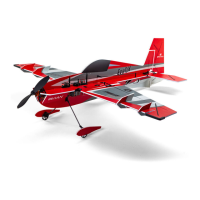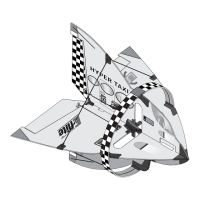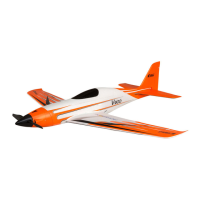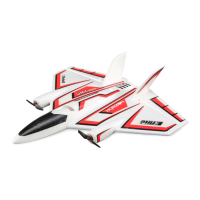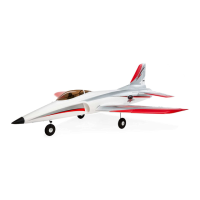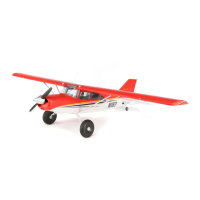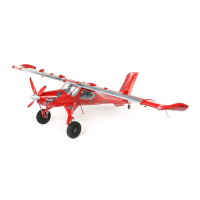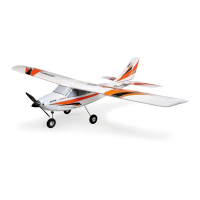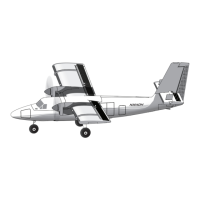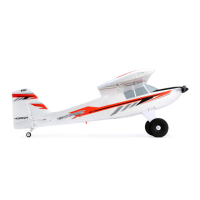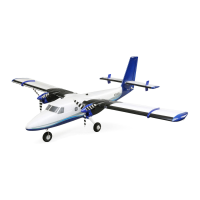EN
19
Replacement Parts Recommended Parts
Part # Description
EFL108006 Cowl: Ultimate 2
EFL108009 Strut Set: Ultimate 2
EFL108010 Strut Wire Clips (4): Ultimate
EFL108011 Pushrod Set: Ultimate 2
EFL108013 Wing Thumb Screws: Ultimate 2
EFL108016 Motor Mount: Ultimate 2
EFL108017 Prop Adapter: Ultimate 2
EFL165501 Painted Fuselage: Ultimate 3D
EFL165502 Top Wing Set: Ultimate 3D
EFL165503 Bottom Wing Set: Ultimate 3D
EFL165504 Horiz Stab Set: Ultimate 3D
EFL165505 Rudder: Ultimate 3D
EFL165507 Landing Gear Set: Ultimate 3D
EFL165512 Control Horn Set: Ultimate 3D
EFL165514 Decal Sheet: Ultimate 3D
EFL165515 Spinner w/ Screw: Ultimate 3D
EFL165516 Stab Joiner Set: Ultimate 3D
EFL165517 Battery Hatch: Ultimate 3D
EFLM108019 Motor Shaft: Ultimate 2
EFLM17552 BL10 Motor 800KV: Turbo Timber
EFLP11606E 11.6 X 6 Propeller : Ultimate 3
SPMAR637T AR637T 6CH SAFE and AS3X TelemRX
SPMSA332 9g servo MG
SPMXAE1060 Avian 60Amp Brushless Smart ESC 6S
Part # Description
SPMR6775 NX6 Transmitter Only MD2
SPMX22004S30 2200mAh 4S 14.8V Smart 30C; IC3
SPMXC2040 Smart S1400 G2 AC Smart Charger, 1X400W
Optional Parts
Part # Description
SPMXBC100 LiPo Cell Voltage Checker
SPM6722 Spektrum Single Aircraft TX Case
SPMA9574 Aircraft Telemetry Airspeed Indicator
SPMA9589 Aircraft Telemetry Altitude and Variometer Sensor
SPMAR9350 AR9350 9 Channel AS3X RX
SPMR12000 iX12 12 Channel Transmitter Only
SPMR8200 NX8 Transmitter Only MD2
SPMR10100 NX10 Transmitter Only MD2
SPMXC2010 Smart S2200 G2 AC Smart Charger, 2X200W
SPMX22003S100 2200mAh 3S 11.1V Smart 100C; IC3
SPMX22003S30 2200mAh 3S 11.1V Smart 30C; IC3
SPMX22003S50 2200mAh 3S 11.1V Smart 50C; IC3
SPMX22004S100 2200mAh 4S 14.8V Smart 100C; IC3
SPMX22004S50 2200mAh 4S 14.8V Smart 50C; IC3
SPMXC10201 30A 540W Power Supply
AMA National Model Aircraft Safety Code
Academy of Model Aeronautics
National Model Aircraft Safety Code
Effective January 1, 2018
A model aircraft is a non-human-carrying device capable of sustained flight within visual line of sight of the pilot or spotter(s). It may not exceed limitations of this
code and is intended exclusively for sport, recreation, education and/or competition. All model flights must be conducted in accordance with this safety code and
related AMA guidelines, any additional rules specific to the flying site, as well as all applicable laws and regulations.
As an AMA member I agree:
• I will not fly a model aircraft in a careless or reckless manner.
• I will not interfere with and will yield the right of way to all human-carrying
aircraftusing AMA’s See and Avoid Guidance and a spotter when appropriate.
• I will not operate any model aircraft while I am under the influence of
alcohol or any drug that could adversely affect my ability to safely control
the model.
• I will avoid flying directly over unprotected people, moving vehicles, and
occupied structures.
• I will fly Free Flight (FF) and Control Line (CL) models in compliance with
AMA’s safety programming.
• I will maintain visual contact of an RC model aircraft without enhancement
other than corrective lenses prescribed to me. When using an advanced
flight system, such as an autopilot, or flying First-Person View (FPV), I will
comply with AMA’s Advanced Flight System programming.
• I will only fly models weighing more than 55 pounds, including fuel, if
certified through AMA’s Large Model Airplane Program.
• I will only fly a turbine-powered model aircraft in compliance with AMA’s
Gas Turbine Program.
• I will not fly a powered model outdoors closer than 25 feet to any individual,
except for myself or my helper(s) located at the flightline, unless I am taking
off and landing, or as otherwise provided in AMA’s Competition Regulation.
• I will use an established safety line to separate all model aircraft operations
from spectators and bystanders.
Problem Possible Cause Solution
Controls reversed Transmitter settings are reversed Perform the Control Direction Test and adjust the controls on transmitter appropriately
Motor power pulses
then motor loses
power
ESC uses default soft Low Voltage Cutoff (LVC) Recharge flight battery or replace battery that is no longer performing
Weather conditions might be too cold Postpone flight until weather is warmer
Battery is old, worn out, or damaged Replace battery
Battery C rating might be too small Use recommended battery
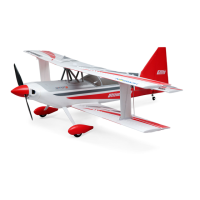
